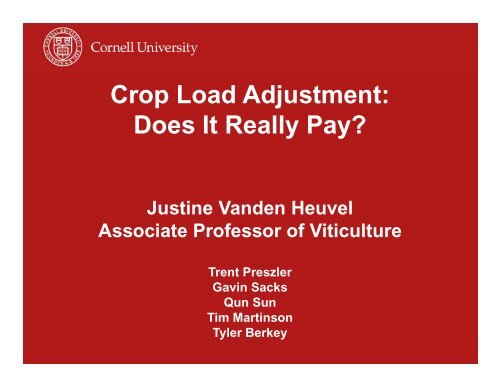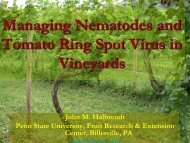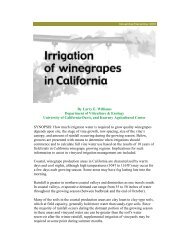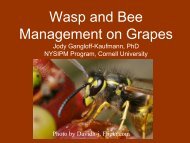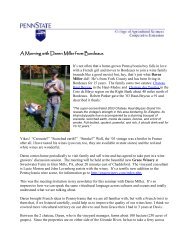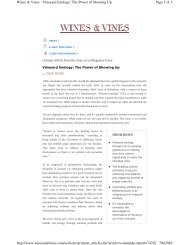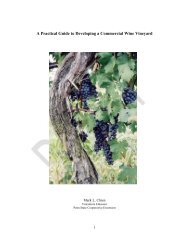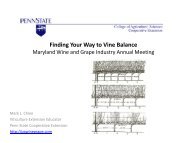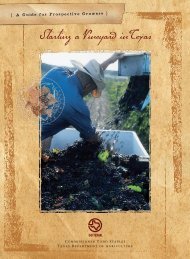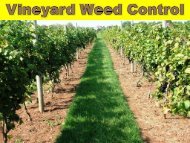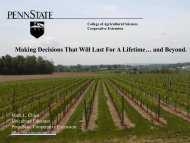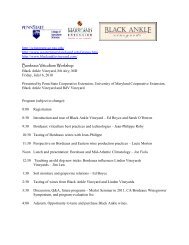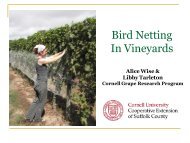Crop Load Adjustment - PA Wine Grape Growers Network
Crop Load Adjustment - PA Wine Grape Growers Network
Crop Load Adjustment - PA Wine Grape Growers Network
You also want an ePaper? Increase the reach of your titles
YUMPU automatically turns print PDFs into web optimized ePapers that Google loves.
<strong>Crop</strong> <strong>Load</strong> <strong>Adjustment</strong>:<br />
Does It Really Pay?<br />
Justine Vanden Heuvel<br />
Associate Professor of Viticulture<br />
Trent Preszler<br />
Gavin Sacks<br />
Qun Sun<br />
Tim Martinson<br />
Tyler Berkey
Clos des Papes<br />
Châteauneuf-du-Pape 2005<br />
98 points / $80<br />
At 98 points, the 2005 is<br />
Avril's best wine yet,<br />
displaying an enormous core<br />
of fruit and minerality along<br />
with massive structure. Avril<br />
keeps yields low….
Columbia Crest, founded in 1978, is part of Ste. Michelle<br />
<strong>Wine</strong> Estates, which accounts for more than half the<br />
wine produced in Washington. With an excellent<br />
growing season in 2005, winemaker Ray Einberger, who<br />
worked at Château Mouton‐Rothschild and Napa's Opus<br />
One, crafted an exceptional wine. He used grapes from<br />
six low‐yielding vineyards…. This wine belongs in the<br />
company of the world's great Cabernets and, with its<br />
low price and significant production, earns our 2009<br />
<strong>Wine</strong> of the Year.
“The Hermann J. Wiemer winery…Quick math tells<br />
you that yields here are low…an eye-opening<br />
number… which distances them from most of the<br />
wines currently produced in the Finger Lakes. (Low<br />
yields, anyone?) If a broader base of consumers is<br />
going to change its perception of Finger Lakes<br />
wines, the region will need more winemakers who<br />
understand how critical low yields are to making<br />
quality wine.”<br />
– James Molesworth, Editor<br />
<strong>Wine</strong> Spectator
The yield/quality relationship<br />
Yield<br />
Quality<br />
Quality<br />
Cluster<br />
thinning<br />
Traditional view<br />
Yield<br />
Modified view
↔<br />
Economic<br />
sustainable,<br />
labor, lost<br />
yields<br />
↑<br />
Soluble<br />
solids,<br />
ripening<br />
CLUSTER<br />
THINNING<br />
pros/cons<br />
↑<br />
Air flow,<br />
light<br />
environ<br />
↔<br />
Flavor<br />
chemistry,<br />
<strong>Wine</strong><br />
Quality<br />
↑<br />
Vine<br />
balance
How does CT affect costs & returns?<br />
• Input<br />
• Total costs per acre to manage Riesling<br />
• Labor costs per acre to thin clusters<br />
• Yield (t/ha) before CT and after CT<br />
• Ouput<br />
• Calculation of minimum price needed to<br />
maintain constant net returns at varying crop<br />
levels
Applying the model to a field study<br />
• Three year study: 2008 - 2010<br />
• King Ferry <strong>Wine</strong>ry, east side Cayuga Lake<br />
• Well-drained Cazenovia series silt loam<br />
• 224m elevation,1.5 x 3.0 m spacing, North-South<br />
• Vitis vinifera L. cv. Riesling cl. 239/RS3309 (1984)<br />
• Winter pruned to consistent bud number, spring<br />
thinned to 36 shoots per vine<br />
• Vertically shoot positioned “Pendelbogen”
Experimental Treatment<br />
• 4 experimental treatments replicated 4 times:<br />
• Low crop (1 cluster remains per shoot)<br />
• Medium crop (1.5 clusters/shoot)<br />
• High crop (2 clusters/shoot)<br />
• Non-thinned control<br />
• Distal clusters removed first, basal left intact<br />
• Cluster thinning at E-L stage 31 (pea-sized)<br />
• Harvested 3 weeks after typical harvest date
Non-thinned
High crop
HIGH CROPLOAD<br />
Medium crop
Low crop
Data Collection<br />
• Canopy characterization & light environment<br />
• Enhanced Point Quadrat Analysis at veraison<br />
• Yield components at harvest (3 weeks late)<br />
• Yield/vine, cluster number, cluster weight<br />
• Pressed juice composition at harvest<br />
• Dissolved soluble solids, pH, Titratable Acidity<br />
• Production economics<br />
• Costs, price, yield analysis for net returns<br />
• <strong>Wine</strong> sensory analysis<br />
• Preference ratings and willingness to pay<br />
(WTP) elicitation among NYC professionals
Table 1 Significant impacts* of cluster thinning on yield components of late<br />
harvest Finger Lakes Riesling, 2008-2010. Measurements are the average of<br />
four field replicates.<br />
Clusters per shoot Clusters per vine Cluster weight (g)<br />
Treatment 2008 2009 2010 2008 2009 2010 2008 2009 2010<br />
Low 1.0 c 1.0 c 1.1 c 27.9 c 37.0 c 41.3 c 91.4 a 59.6 a 53.4 a<br />
Medium 1.5 b 1.6 b 1.4 b 39.3 b 56.5 b 49.8 b 75.7 b 51.6 a 51.1 a<br />
High 2.1 a 2.0 a 1.9 a 57.8 a 72.3 a 69.7 a 63.7 b 47.3 a 36.0 b<br />
Control 2.2 a 1.9 a 1.7 a 59.0 a 67.6 a 62.0 a 67.7 b 54.3 a 43.0 b<br />
Berry weight (g) Yield/hectare (t) Yield/vine (kg)<br />
Treatment 2008 2009 2010 2008 2009 2010 2008 2009 2010<br />
Low 1.83 a 1.28 a 1.52 a 5.5 c 4.7 b 4.7 a 2.5 c 2.2 b 2.2 a<br />
Medium 1.73 a 1.17 b 1.50 a 6.4 b 6.3 a 5.5 a 3.0 b 2.9 b 2.5 a<br />
High 1.41 b 1.07 b 1.34 b 7.9 a 7.3 a 5.4 a 3.7 a 3.4 a 2.5 a<br />
Control 1.48 b 1.04 b 1.22 b 8.4 a 7.8 a 5.8 a 3.9 a 3.6 a 2.7 a<br />
* Means analyzed by SAS GLM PROC and significance indicated by different letters at p ≤ 0.05.
Table 1 Significant impacts* of cluster thinning on late harvest Finger Lakes<br />
Riesling, 2008-2010. Measurements are the average of four field replicates.<br />
<strong>Crop</strong> load<br />
(yield/pruning wt) Pressed juice Brix CEFA<br />
Treatment 2008 2009 2010 2008 2009 2010 2008 2009 2010<br />
Low 3.3 c 3.2 c 2.9 b 19.6 a 19.9 a 21.4 a 0.18 a 0.28 b 0.21 a<br />
Medium 4.1 b 4.8 b 4.1 a 19.4 a 19.5 a 20.3 b 0.23 a 0.29 b 0.25 a<br />
High 5.7 a 6.6 a 4.2 a 17.5 b 18.2 b 19.5 b 0.23 a 0.32 b 0.24 a<br />
Control 6.3 a 7.0 a 4.6 a 17.1 b 17.8 b 19.1 b 0.26 a 0.39 a 0.32 a<br />
* Means analyzed by SAS GLM PROC and significance indicated by different letters at p ≤ 0.05.
Table 1 Significant impacts* of cluster thinning on late harvest Finger Lakes<br />
Riesling, 2008-2010. Measurements are the average of four field replicates.<br />
<strong>Crop</strong> load<br />
(yield/pruning wt) Pressed juice Brix CEFA<br />
Treatment 2008 2009 2010 2008 2009 2010 2008 2009 2010<br />
Low 3.3 c 3.2 c 2.9 b 19.6 a 19.9 a 21.4 a 0.18 a 0.28 b 0.21 a<br />
Medium 4.1 b 4.8 b 4.1 a 19.4 a 19.5 a 20.3 b 0.23 a 0.29 b 0.25 a<br />
High 5.7 a 6.6 a 4.2 a 17.5 b 18.2 b 19.5 b 0.23 a 0.32 b 0.24 a<br />
Control 6.3 a 7.0 a 4.6 a 17.1 b 17.8 b 19.1 b 0.26 a 0.39 a 0.32 a<br />
* Means analyzed by SAS GLM PROC and significance indicated by different letters at p ≤ 0.05.
Table 2 Production costs, price, yield and revenue parameters for late harvest<br />
Finger Lakes Riesling, 2008-2010, as expressed by metrics of previously<br />
published cluster thinning economic model.<br />
Market price ($/t) Yield after CT (t/ha) Revenue ($/ha)<br />
Treatment 2008 2009 2010 2008 2009 2010 2008 2009 2010<br />
Low 2660 2350 2400 5.5 4.7 4.7 14,630 11,045 11,280<br />
Medium 2660 2350 2400 6.4 6.3 5.5 17,024 14,805 13,200<br />
High 2660 2350 2400 7.9 7.3 5.4 21,014 17,155 12,960<br />
Control 2660 2350 2400 8.4 7.8 5.8 22,344 18,330 13,920<br />
Total production<br />
cost ($/ha)<br />
Grower net returns<br />
($/ha)<br />
Treatment 2008 2009 2010 2008 2009 2010<br />
Low 6,369 6,357 6,344 8,261 4,688 4,936<br />
Medium 6,338 6,320 6,326 10,686 8,485 6,874<br />
High 6,301 6,301 6,307 14,713 11,225 7,030<br />
Control 5,930 5,930 5,930 16,414 12,029 7,613
Dollars per hectare<br />
18,000<br />
16,000<br />
14,000<br />
12,000<br />
10,000<br />
8,000<br />
6,000<br />
Grower Net Returns<br />
Low<br />
Medium<br />
High<br />
Control<br />
4,000<br />
2,000<br />
0<br />
2008 2009 2010<br />
Year
Price differential after<br />
CT ($/bottle)<br />
Treatment 2008 2009 2010<br />
Low 3.03 3.36 1.33<br />
Medium 1.83 1.27 0.42<br />
High 0.44 0.43 0.51<br />
Control 0 0 0
<strong>Wine</strong>making<br />
• Fruit combined from field replicates of each<br />
treatment, whole cluster pressed, split in<br />
duplicate 19L carboys<br />
• Juice adjusted to 22Brix before fermentation at<br />
16°C (equivalent potential alcohol)<br />
• Fermentation stopped with 6-10% residual sugar<br />
for “medium sweet” by Int’l Riesling Foundation<br />
• Bottled after 3 months w/o adjustments, filtering
<strong>Wine</strong> basic analysis<br />
pH TA (g/L) Alcohol (%v)<br />
Treatment 2009 2010 2009 2010 2009 2010<br />
Low 2.87 a 3.07 a 11.1 a 9.8 a 9.3 a 10.0 a<br />
Medium 2.86 a 3.09 a 11.0 a 10.0 a 9.8 a 10.2 a<br />
High 2.85 a 3.09 a 11.2 a 10.0 a 9.6 a 10.3 a<br />
Control 2.86 a 3.07 a 11.3 a 9.9 a 9.5 a 10.1 a
• NYC #1 wine market in US<br />
• Consumes 30% of total imports<br />
• Driven by market gatekeepers<br />
• Evaluate price premiums on<br />
wine attributes at WSET HQ
<strong>Wine</strong> sensory WTP trial in NYC<br />
• No up-front training or attribute selection<br />
• 27 panelists all working in wine sales and<br />
distribution, writers, bloggers, PR<br />
• 21 graduated WSET Level 4 Diploma or M.W.<br />
• <strong>Wine</strong> poured in 30mL samples, ISO glass<br />
• Panelists asked to free-scale rate (0-10cm)<br />
fruitiness, petrol, mouthfeel, likability, likelihood<br />
of purchase<br />
• Provide everyday LH Riesling WTP and max.<br />
WTP for each wine tasted
Average Rating (0 to 4)<br />
2.50<br />
2.00<br />
1.50<br />
1.00<br />
0.50<br />
0.00<br />
Low<br />
Medium<br />
High<br />
Control<br />
a<br />
a<br />
a<br />
a a a a<br />
a<br />
b b a a<br />
Purchase Petrol Like Fruit Structure<br />
Sensory or Preference Attribute<br />
Figure, 2009 wines: Sensory evaluation and preference rating by New York City wine industry<br />
professionals of late harvest Finger Lakes Riesling wines made in 2009 from vines cluster thinned<br />
to varying levels. Response means for 27 panelists followed by different letters differ at p ≤ 0.05.<br />
a<br />
b<br />
a<br />
a<br />
b<br />
a<br />
a<br />
a
Average Rating (0 to 4)<br />
3.00<br />
2.50<br />
2.00<br />
1.50<br />
1.00<br />
0.50<br />
0.00<br />
Low<br />
Medium<br />
High<br />
Control<br />
a<br />
a<br />
a<br />
a<br />
a<br />
a<br />
a a a a a<br />
Petrol Purchase Like Structure Fruit<br />
a<br />
b<br />
b<br />
b<br />
a<br />
a a a<br />
a<br />
Sensory or Preference Attribute<br />
Figure, 2010 wines: Sensory evaluation and preference rating by New York City wine industry<br />
professionals of late harvest Finger Lakes Riesling wines made in 2010 from vines cluster thinned to<br />
varying levels. Response means for 27 panelists followed by different letters differ at p ≤ 0.05.
Dollars per Bottle<br />
20.0<br />
18.0<br />
16.0<br />
14.0<br />
12.0<br />
10.0<br />
8.0<br />
6.0<br />
Willingness to pay by NYC <strong>Wine</strong> Professionals<br />
for Late Harvest FL Riesling<br />
Low<br />
Medium<br />
High<br />
Control<br />
a a<br />
a<br />
a a<br />
a<br />
a<br />
a<br />
4.0<br />
2.0<br />
0.0<br />
2009 2010<br />
Year
Shoot and cluster thinning for hybrids<br />
How much does it cost?<br />
What are the benefits?
Marechal foch<br />
Control<br />
Shoot-thinned<br />
Early harvest: Sept. 11<br />
Late harvest: Sept. 18
Tannins in wine improved with ST<br />
b<br />
a<br />
b<br />
a<br />
b<br />
b<br />
a<br />
a<br />
CE = control, early harvest, CL = control, late harvest<br />
STE = shoot thinned, early harvest, STL = shoot thinned, late harvest
Unpleasant aromas decreased with ST<br />
fruit,<br />
banana,<br />
apple,<br />
rose<br />
solvent,<br />
fruit,<br />
potato,<br />
chocolate<br />
sweat,<br />
cheese<br />
flower,<br />
apple<br />
sweet,<br />
clove,<br />
smoke,<br />
bandaid<br />
grass,<br />
green
To maintain revenue $2,460 (2007) and<br />
$4,662 (2008) per acre in Foch vineyard:<br />
Control<br />
(2007)<br />
ST (2007)<br />
Control<br />
(2008)<br />
Yield (t/a) 4.1 3.3 7.0 5.3<br />
ST (2008)<br />
Add. costs<br />
per acre<br />
Add. cost<br />
per ton<br />
Req.<br />
price/ton<br />
Add. Bottle<br />
price<br />
$0 $54 $0 $54<br />
$0 $16.36 $0 $10.18<br />
$600 (avg) $761 $666<br />
(avg)<br />
$890<br />
$0 $0.22 $0 $0.31<br />
ST wine significantly different than control in 2007 by 24-member sensory panel
To maintain revenue of $7,356 per acre in<br />
Seyval vineyard:<br />
Control ST CT ST+CT<br />
Yield (t/a) 12.0 9.6 8.1 6.6<br />
Add. costs<br />
per acre<br />
Add. cost<br />
per ton<br />
Req. price<br />
per ton<br />
Add. bottle<br />
price<br />
$0 $54 $62 $116<br />
$0 $5.62 $7.65 $17.57<br />
$613 (avg) $772 $915 $1,132<br />
$0 $0.22 $0.42 $0.72<br />
CT wine significantly preferred over control by 26-member consumer panel
To maintain revenue of $6,499 per acre in Corot<br />
noir vineyard:<br />
Control ST CT ST+CT<br />
Yield (t/a) 10.35 9.39 7.97 7.02<br />
Add. costs<br />
per acre<br />
Add. cost<br />
per ton<br />
Req. price<br />
per ton<br />
Add. bottle<br />
price<br />
$0 $54 $62 $116<br />
$0 $5.75 $7.77 $16.52<br />
$628 (avg) $698 $823 $942<br />
$0 $0.10 $0.27 $0.44<br />
ST+CT “fruitier” than control and ST by 16-member sensory panel
Labor time and cost (@$15/hr)<br />
for thinning<br />
Vine<br />
spacing<br />
Vines per<br />
acre<br />
Hr per<br />
acre<br />
$ per<br />
acre<br />
Hr per<br />
acre<br />
$ per<br />
acre<br />
15 sec per vine 30 sec per vine<br />
4 x 9 1210 5.0 $76 10.1 $151<br />
5 x 9 968 4.0 $61 8.1 $121<br />
6 x 9 807 3.4 $50 6.7 $101<br />
7 x 9 691 2.9 $43 5.8 $86<br />
8 x 9 605 2.5 $38 5.0 $76
Original<br />
tons<br />
Additional $ per ton required to<br />
maintain gross revenue with<br />
Tons left<br />
thinning<br />
Required additional price per ton<br />
$300 $500 $1,000 $1,500<br />
3 2 $150 $250 $500 $750<br />
4 3 $100 $167 $333 $500<br />
5 4 $75 $125 $250 $375<br />
6 5 $60 $100 $200 $300<br />
7 6 $50 $83 $167 $250
Additional $ per bottle required to<br />
Original<br />
tons<br />
maintain gross revenue with<br />
Tons left<br />
thinning<br />
Price per ton<br />
$300 $500 $1,000 $1,500<br />
3 2 $0.32 $0.35 $0.69 $1.04<br />
4 3 $0.14 $0.23 $0.46 $0.69<br />
5 4 $0.10 $0.17 $0.35 $0.52<br />
6 5 $0.08 $0.14 $0.28 $0.42<br />
7 6 $0.07 $0.12 $0.23 $0.35
Does it pay to reduce cropload?<br />
• <strong>Wine</strong>s from lower cropped vines are not always<br />
preferred by consumers, and they often won’t pay a<br />
premium for it<br />
• For a grower, only if winery will pay a premium<br />
(unless vines are overcropped)<br />
• For a winery, maybe – required premium for<br />
preferred wines generally low ($0.44 per bottle)


